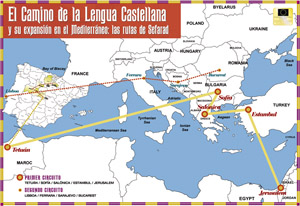



The “Camino de la Lengua Castellana” (Route of the Castilian Language) is an itinerary based around the history of the Castilian (Spanish) language and passes through places which were important in its origins, development and expansion. These places are San Millán de la Cogolla (La Rioja), Santo Domingo de Silos (Burgos), Valladolid, Salamanca, Ávila and Alcalá de Henares (Madrid), four of which are World Heritage Sites.
 The route aims to disseminate the historical heritage of the towns and their people, merging what is shared and what is different in each of them. It aims to encourage the tourist to follow this route along which they will find squares, monasteries, libraries, landscapes, streets, references to writers, literary works, traditional local products and cultural traditions which, in an amenable, relaxing way, will allow them to find out much more about the Castilian (Spanish) language and its history.
The route aims to disseminate the historical heritage of the towns and their people, merging what is shared and what is different in each of them. It aims to encourage the tourist to follow this route along which they will find squares, monasteries, libraries, landscapes, streets, references to writers, literary works, traditional local products and cultural traditions which, in an amenable, relaxing way, will allow them to find out much more about the Castilian (Spanish) language and its history.
The history of Castilian is not only limited to Spain, it also has an important link with other countries where the Jews emigrated when they left Spain in the 15th century. These are the so-called Sephardic Jews and they have kept the language alive for many years in the places where they settled. These places in the Mediterranean are Jerusalem (Israel), Istanbul (Turkey), Salonika (Greece), Sophia (Bulgaria) and Tetuán (Morocco).
This complete route is called “The route of the Castilian language and its expansion in the Mediterranean: the Sephardic routes”
 The “Route of the Castilian Language” is not just the history of a language, but also of countries and peoples. Something which takes on special interest are the migrations lived by the Sephardic Jews who left Spain but kept alive in other countries the tongue in which they had communicated with each other for centuries. The history of this language, an intangible heritage asset, becomes visible through its different cultural and tourist expressions, within the reach of the visitor. The itinerary opens up cooperation and exchanges between regions which while being different, have things in common. Harmonising what is shared and what is different, is part of the route’s rich fabric.
The “Route of the Castilian Language” is not just the history of a language, but also of countries and peoples. Something which takes on special interest are the migrations lived by the Sephardic Jews who left Spain but kept alive in other countries the tongue in which they had communicated with each other for centuries. The history of this language, an intangible heritage asset, becomes visible through its different cultural and tourist expressions, within the reach of the visitor. The itinerary opens up cooperation and exchanges between regions which while being different, have things in common. Harmonising what is shared and what is different, is part of the route’s rich fabric.
The route has been recognised as a European Cultural Itinerary (2002) and Major Cultural Route of the Council of Europe (2004)
Jerusalem: It’s known as an important holy city, symbolizing the Jewish faith. Jerusalem is the origin of the diaspora.
Istambul: The city and the Ottoman Empire are closely bound. There are some surviving Sephardic communities really integrated with ottoman institutions.
 Thessaloniki: The city is known as “The Sephardic Pearl”. The most important years happened between XVII and XVII centuries. In Thessaloniki we can find a Sephardic museum about the life of the Jews in the city. This city it’s a very important symbol about the Holocaust. (Around 50.000 Jews were exterminated in Thessaloniki).
Thessaloniki: The city is known as “The Sephardic Pearl”. The most important years happened between XVII and XVII centuries. In Thessaloniki we can find a Sephardic museum about the life of the Jews in the city. This city it’s a very important symbol about the Holocaust. (Around 50.000 Jews were exterminated in Thessaloniki).
Sofia: The city has a Sephardic community with around 2.000 people and and very important architecture heritage vestiges.
Tetouan: The city is a symbol about the most important Sephardic community in the Maghrebi world.